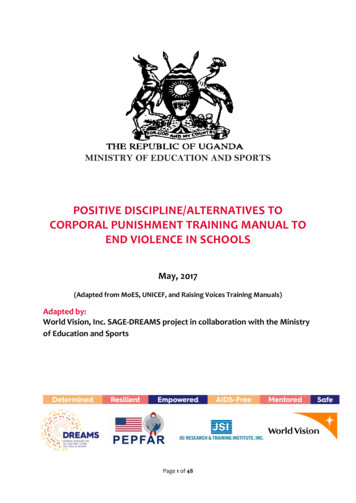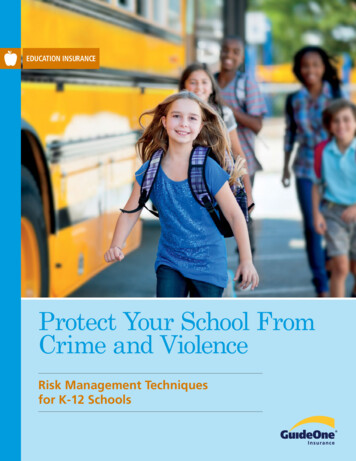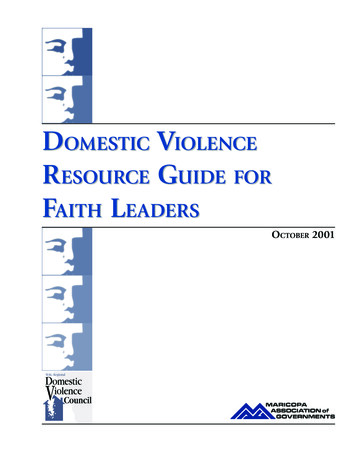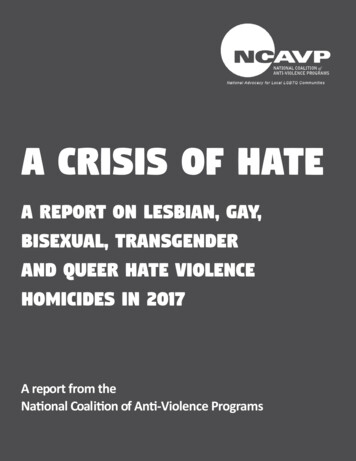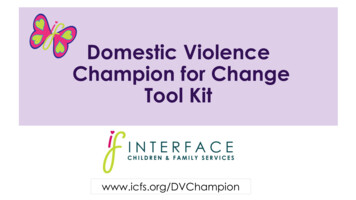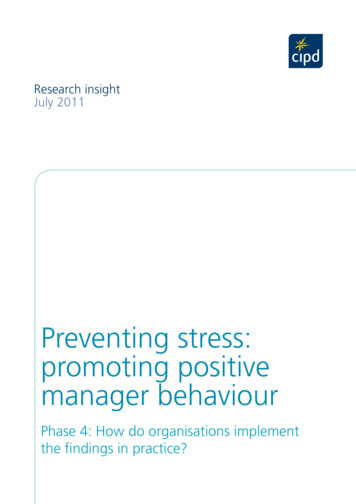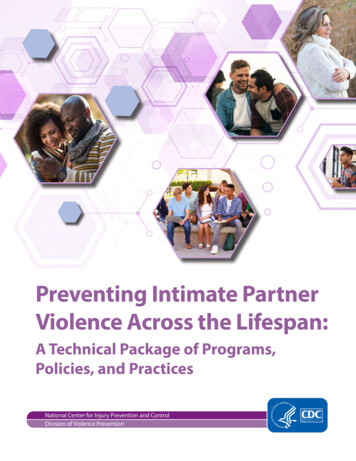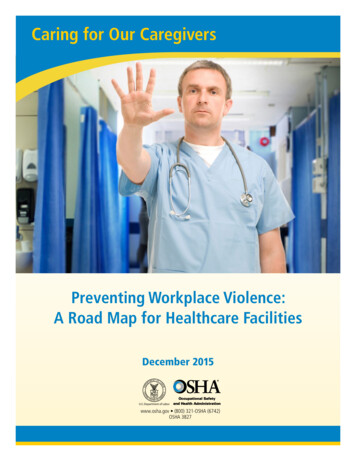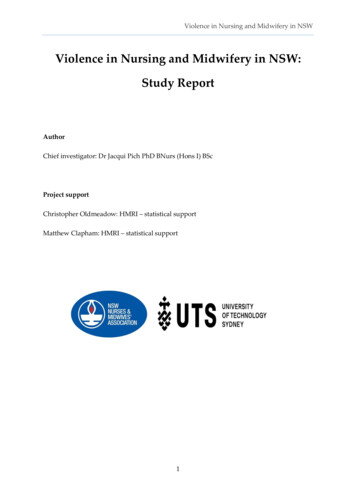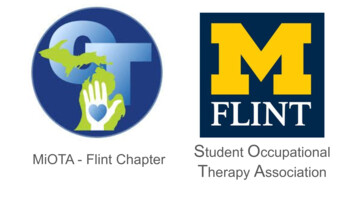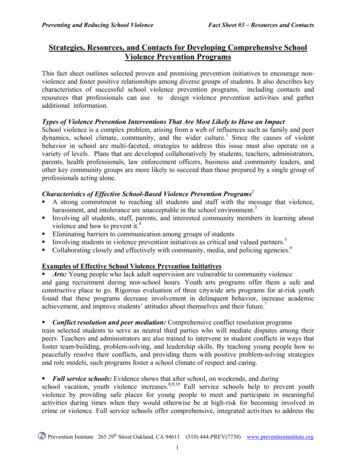
Transcription
Preventing and Reducing School ViolenceFact Sheet #3 – Resources and ContactsStrategies, Resources, and Contacts for Developing Comprehensive SchoolViolence Prevention ProgramsThis fact sheet outlines selected proven and promising prevention initiatives to encourage nonviolence and foster positive relationships among diverse groups of students. It also describes keycharacteristics of successful school violence prevention programs, including contacts andresources that professionals can use to design violence prevention activities and gatheradditional information.Types of Violence Prevention Interventions That Are Most Likely to Have an ImpactSchool violence is a complex problem, arising from a web of influences such as family and peerdynamics, school climate, community, and the wider culture.1 Since the causes of violentbehavior in school are multi-faceted, strategies to address this issue must also operate on avariety of levels. Plans that are developed collaboratively by students, teachers, administrators,parents, health professionals, law enforcement officers, business and community leaders, andother key community groups are more likely to succeed than those prepared by a single group ofprofessionals acting alone.Characteristics of Effective School-Based Violence Prevention Programs2 A strong commitment to reaching all students and staff with the message that violence,harassment, and intolerance are unacceptable in the school environment.3 Involving all students, staff, parents, and interested community members in learning aboutviolence and how to prevent it.4 Eliminating barriers to communication among groups of students Involving students in violence prevention initiatives as critical and valued partners.5 Collaborating closely and effectively with community, media, and policing agencies.6Examples of Effective School Violence Prevention Initiatives Arts: Young people who lack adult supervision are vulnerable to community violenceand gang recruitment during non-school hours. Youth arts programs offer them a safe andconstructive place to go. Rigorous evaluation of three citywide arts programs for at-risk youthfound that these programs decrease involvement in delinquent behavior, increase academicachievement, and improve students’ attitudes about themselves and their future.7 Conflict resolution and peer mediation: Comprehensive conflict resolution programstrain selected students to serve as neutral third parties who will mediate disputes among theirpeers. Teachers and administrators are also trained to intervene in student conflicts in ways thatfoster team-building, problem-solving, and leadership skills. By teaching young people how topeacefully resolve their conflicts, and providing them with positive problem-solving strategiesand role models, such programs foster a school climate of respect and caring. Full service schools: Evidence shows that after school, on weekends, and duringschool vacation, youth violence increases.8,9,10 Full service schools help to prevent youthviolence by providing safe places for young people to meet and participate in meaningfulactivities during times when they would otherwise be at high-risk for becoming involved incrime or violence. Full service schools offer comprehensive, integrated activities to address thePrevention Institute 265 29th Street Oakland, CA 94611 (510) 444-PREV(7738) www.preventioninstitute.org1
Preventing and Reducing School ViolenceFact Sheet #3 – Resources and Contactsphysical, social, emotional, and educational needs of young people and their families andcommunities. They may also provide academic and computer classes, sports activities, jobtraining, leadership and support groups, parenting classes, counseling, drama, art, and musicclasses, and other programs that the community considers important. Peer and adult mentoring: Mentoring programs allow young people to buildsustained, positive relationships with older peers and adults, and motivate them to emulatepositive behavior. Such interactions help reduce risk behaviors in students, 11 and create a safeand secure atmosphere in school so that students feel comfortable talking to adults if they needto. Peer mentoring can also help to increase understanding between diverse groups, strengthenthe sense of community within a school, and build the self-esteem of those participating. Safe Schools/Healthy Students Initiative: The Safe Schools/Healthy StudentsInitiative is a federal grants initiative, jointly sponsored by the U.S. Department of Education, theDepartment of Justice, and the Department of Health and Human Services. Its goal is to preventyouth violence and promote healthy child development by promoting comprehensiveeducational, mental health, social, law enforcement, and juvenile justice services. Safe schoolsplans must 1) build a safe school environment,2) address substance abuse, 3) conduce primary violence prevention, 4) provide mental healthservices (preventative and treatment) both in school and in the community, early childhoodpsychosocial and emotional development programs, (5) education reform, and (6) safe schoolpolicies.Examples of Selected Violence Prevention Curricula and ProgramsNote: While several of these curricula have been evaluated, others have not. However, allcurricula listed below show great promise for reducing conflict and violence in schools andbuilding students’ skills. In addition, several of these curricula and programs have beenhighlighted as exemplary or promising by the U.S. Department of Education, Safe and DrugFree Schools Program. These programs will be identified with an asterisk(*). Aggressors, Victims, and Bystanders (AVB) Violence Prevention Curriculum*This curriculum examines violence among peers, including the roles that young people play inpotentially violent situations (aggressor, victim, or bystander). It helps students to understand thedynamics of a situation, define their problems and goals, and generate positive solutions in waysthat will not lead to fights. The curriculum has been found to increase students’ desire to resolveconflicts peacefully and decrease their acceptance and encouragement of aggression. For moreinformation, contact: Education Development Center, Inc., 55 Chapel Street, Newton, MA02158; Phone: (800) 225-4276; http://www.edc.org Flashpoint IIThis curriculum explores hate crimes, civil rights, prejudice, and stereotyping, and providesyoung people with skills for analyzing the media’s depiction of ethnic, racial, and religiousgroups. It also helps adolescents to build better relationships with diverse groups, and gives themstrategies they can implement and use to help victims. This curriculum has been integrated intothe Massachusetts school system and is currently being evaluated by the Office of JuvenileJustice and Delinquency Prevention (OJJDP). For more information, contact: Ruth Budelmann,Prevention Institute 265 29th Street Oakland, CA 94611 (510) 444-PREV(7738) www.preventioninstitute.org2
Preventing and Reducing School ViolenceFact Sheet #3 – Resources and ContactsFlashpoint Program Director, Director of Juvenile Justice Programs, Essex County,Massachusetts, District Attorney Kevin Burke’s Office; Phone: (978) 745-6610 x. 155 Healing the Hate: A National Bias Crime Prevention CurriculumThis curriculum helps middle school students to respond to and prevent hate crime. It is based onthe principle that violence and prejudice are learned and therefore preventable. The curriculum(Doc # NCJ 165479) is available free online from http://www.ncjrs.org/pdffiles1/165479.pdf orby writing P.O. Box 6000, Rockville, MD 20849-6000; Phone: (800) 638-8736; Fax: (410) 7924358; E-mail: askncjrs@ncjrs.org Lions-Quest Working Toward Peace*Lions-Quest WTP brings together the school, the family, peers, community, and the media in anetwork of support to teach and reinforce anger and conflict management skills. For moreinformation, contact Greg Long, Quest International, 1984 Coffman Rd, Neward, OH; Phone:(740) 522-6400; FAX: (740) 522-6580; E-mail: gregl@quest.edu; http://www.quest.edu Michigan Model for Comprehensive School Health Education*The Michigan Model brings together an array of national, state, and private resources to promotecomprehensive school health from kindergarten through high school. The goals of the programare to provide common language and approaches for parent, community, and student healthprograms; and reinforce prevention messages from a variety of levels. For more information,contact: The Educational Materials Center, 139 Combined Services Building, Central MichiganUniversity, Mt. Pleasant, MI 48859; Phone: (517) 774-3986 or 1-800-214-8961; Fax: (517) 7743943; E-mail: emc@cmich.edu; http://www.emc.cmich.edu/mm/default.htm Open Circle Curriculum *The Open Circle Curriculum is a social and emotional learning curriculum that targetselementary school students and focuses on strengthening their communication, self-control, andsocial problem-solving skills. The program also aims to promote the creation of growth-fosteringrelationships among students and between students and the adults in their lives; and to build asense of community in classrooms and schools by fostering communication among students andbetween students and their teachers. For more information, contact: Pamela Seigle, The StoneCenter, Wellesley Centers for Women, Wellesley College; 106 Central St., Wellesley, MA02481-8203; Phone: (781) 283-3778; Fax: (781) 283-3717; E-mail: pseigle@wellesley.edu;www.wellesley.edu/OpenCircle PeaceBuilders *PeaceBuilders is a school-wide violence prevention program for elementary and middleschools that aims to reinforce positive behavior at school, home, in after school settings, peerinteractions, and the mass media. For more information, contact PeaceBuilders: P.O. Box 12158,Tucson, AZ 85732; Tel: (520) 322-9977 or (877) 4 PEACE NOW; Fax: (520) 322-9983; E-mail:info@peacebuilders.com; www.peacebuilders.com The Peacemakers Program: Violence Prevention for Students in Grades 4-8*The goal of the Peacemakers Program is to reduce aggression and violence among youth, andtrain students in conflict-related psychosocial skills, including anger management, unbiasedPrevention Institute 265 29th Street Oakland, CA 94611 (510) 444-PREV(7738) www.preventioninstitute.org3
Preventing and Reducing School ViolenceFact Sheet #3 – Resources and Contactssocial perception, conflict avoidance, problem-solving, and assertiveness. For more information,contact: Joella Burgoon, (216) 696-6823 ext. 1152; E-mail: Peacemakers@applewoodcenters.org The Positive Adolescent Choices Training (PACT) ProgramPACT teaches adolescents appropriate social skills, and helps them learn how to recognize andcontrol angry emotions that can escalate conflict. The curriculum is culturally sensitive toAfrican-American youth and videotaped training vignettes feature contemporary AfricanAmerican youth. Students learn how to give positive and negative feedback, resist peer pressure,and problem-solve effectively. Evaluation has showed that this program is statistically significantin raising anger management and social skills and lowering reports of violent and aggressivebehavior. For more information, contact Research Press: 2612 North Mattis Avenue,Champaign, IL 61822-1053; Phone: (800) 519-2707; Fax: (217) 352-1221; E-mail:rp@researchpress.com; www.researchpress.com Primary Mental Health Project (PMHP)*PMHP is a school-based early intervention program that targets children in preschool- grade 3who show evidence of early school adjustment difficulties. The program seeks to detect, reduce,and/or prevent social, emotional, and school adjustment difficulties, and enhance learning andadjustment skills and other school-related competencies. In the 40 years since it began, PMHPhas been thoroughly tested. Long-term effects were found up to five years after the interventionthat showed treatment children to be better adjusted than a demographically comparable group.PMHP has since been adopted in more than 700 school districts around the world. For moreinformation, contact: Deborah Johnson, Children’s Institute, 274 N. Goodman, Suite D103,Rochester, NY 14607; Phone: (877) 888-7647 or (716) 295-1000; FAX: (716)295-1090; E-mail:djohnson@childrensinstitute.net; http://www.childrensinstitute.net/ Resolving Conflict Creatively Program (RCCP)RCCP is a research-based, K-12 program that seeks to change the culture of schools to ensurethat young people develop social and emotional skills to reduce violence and prejudice, formcaring relationships, and build healthy lives. RCCP is the nation’s largest and longest-runningconflict resolution program for schools, and is currently being used in over 375 schoolsnationwide. It has been found to benefit all children regardless of gender, grade, or risk status,with RCCP participants being less likely to perceive their social world as hostile, and more likelyto view violence as unacceptable and chose a nonviolent solution to conflict. For moreinformation, contact: Jennifer Selfridge, Program Director, 23 Garden Street, Cambridge, MA02131; Phone: (617) 492-1764 x 31; Fax: (617) 864-5164; Email: ut-rccp.html. Responding in Peaceful and Positive Ways (RIPP)*RIPP is a primary prevention program designed for implementation in middle and junior highschools. The program aims to reduce problem behaviors by implementing strategies that addressspecific risk factors and increase protective factors. RIPP participants were more likely to utilizethe peer mediation program, and showed significantly lower rates of fighting, bringing weaponsto school, and in-school suspensions than control subjects. For more information, contact:Melanie McCarthy, 808 W. Franklin St., Box 2018, Richmond VA 23284-2018; Phone: (804)Prevention Institute 265 29th Street Oakland, CA 94611 (510) 444-PREV(7738) www.preventioninstitute.org4
Preventing and Reducing School ViolenceFact Sheet #3 – Resources and Contacts828-8793; Fax: (804) 827-1511; E-mail: m/0-306-46386-5 Second Step Social Skills CurriculumThis curriculum teaches preschool- junior high students social skills to reduce impulsive andaggressive behavior and increase their level of social competence. Evaluation has concluded thatthe Second Step curriculum leads to moderate decreases in aggression and increases in neutraland pro-social behavior in school.12 This curriculum has been chosen as an exemplary programby a panel of experts from the U.S Department of Education, Safe and Drug-Free Schools. Formore information, contact: Committee for Children, 2203 Airport Way South, Suite 500, Seattle,WA 98134; Phone: (800) 634-4449; Web: http://www.cfchildren.org SOAR (Skills, Opportunities, and Recognition)*Soar (Skills, Opportunities, and Recognition) is an intervention for teachers, parents, andstudents in Grades 1-6. It is a universal prevention program with interventions designed toreduce specific, empirically identified risk factors and to increase protective factors at theindividual, peer, family, and school levels. For more information, contact: For more information,contact: Ms. Regina Serrano, Director, Office of Multicultural Recruitment and Retention,University of Arizona, College of Education, Phone: (520) 621-1827) or Mr. Roger Pfeuffer,Assistant Superintendent, Tucson Unified School District, Phone: (520) 617-7292 Social Decision Making and Problem Solving*The primary goal of this program is to prevent unhealthy life decisions by providing elementaryschool students with foundational skills necessary to think clearly under stress and in emotionaland socially complex situations. For more information, contact: Linda Bruene Butler, Universityof Medicine & Dentistry of NJ, UBHC - Behavioral Research and Training Institute, LibertyPlaza, 335 George St. - 3rd Fl. New Brunswick, NJ 08901; Phone: (732) 235-9280; Fax: (732)235-9277; E-mail: spsweb@ umdnj.edu; www.umdnj. edu/spsweb The Strengthening Families Program: For Parents and Youth 10-14*The curriculum is a universal preventive intervention designed for parents of all educationallevels and their young adolescent children. Intermediate objectives of the curriculum includeimproved skills in nurturing and child management by parents, improved interpersonal andpersonal competencies among youth, and improved pro-social skills in youth. SFP is recognizedby many federal agencies (e.g., NIDA, OJJDP, CSAP, CMHS, DoEd, ONDCP, and NIAAA) asan exemplary, research-based family model. For more information contact: Karol L. Kumpfer,University of Utah, 250 So. 1850 E. Rm. 215, Salt Lake City, UT 84112; Phone: (801) 5818498; Fax: (801) 581-5872; E-mail: karol.kumpfer@health.utah.eduAdditional Resources and ContactsGeneralAmerican School Health Association (ASHA) unites the many professionals who are committedto safeguarding the health of school-aged children. A report on the National Injury and ViolencePrevention Task Force is available from ASHA at http://www.ashaweb.org.Prevention Institute 265 29th Street Oakland, CA 94611 (510) 444-PREV(7738) www.preventioninstitute.org5
Preventing and Reducing School ViolenceFact Sheet #3 – Resources and ContactsAnnual School Safety Reports can be found at http://www.ed.gov.Berkeley Media Studies Group (BMSG) works to provide diverse groups with the skills to accessthe news media, frame health problems in a social context, and use mass media as a tool tostrengthen and advance health policy at the community level. Phone: (510) ers.htm#bmsBlueprints for Violence Prevention: This nationally recognized center provides model violenceprevention programs that identify the important components involved in preventing bout/main.htmCDC Adolescent and School Health Information provides data on adolescent health riskbehaviors, including violence and unintentional injury, and school health policies and programs.http://www.cdc.gov/nccdphp/dashCenter for Health and Health Care in Schools (CHHCS) studies programs that provide healthpromotion and health care services to youth in schools, and helps school-based health centersdetermine how to best provide dental and mental health care to students. CHHCS also studiespractices for coordinating school-based health education and primary care services with theoverall health care delivery system. www.healthinschools.orgCenter for the Prevention of School Violence provides resources for initiating safe schoolplanning and keeps the public informed through its public awareness /index.htmlChildren’s Safety Network provides resources and technical assistance to maternal and childhealth practitioners and others working to reduce intentional and unintentional injuries amongchildren and adolescents. www.childrensafetynetwork.orgEarly Warning, Timely Response: A Guide to Safe Schools offers research-based practicesdesigned to assist school communities identify warning signs early and develop prevention,intervention, and crisis response plans. It includes information on what characterizes a schoolthat is safe and responsive to all children, early warning signs, getting help for troubled children,developing a prevention and response plan, responding to crisis resources, methodology,contributors, and research support. The guide is available online ml.ERIC Clearinghouse on Urban Education: This comprehensive guide contains listings ofresearch studies, program overviews, and links to agencies addressing youth violence. http://ericweb.tc.columbia.edu/pathways/youth violenceHamilton Fish Institute provides a listing of violence prevention programs that have beenformally evaluated, as well as examples of noteworthy programs that are still being ms/index.php3Prevention Institute 265 29th Street Oakland, CA 94611 (510) 444-PREV(7738) www.preventioninstitute.org6
Preventing and Reducing School ViolenceFact Sheet #3 – Resources and ContactsKeep Schools Safe is a project of the National Association of Attorneys General and the NationalSchool Boards Association that is designed to provide up-to-date information on successfulyouth violence prevention programs and assist communities in developing safe school plans.http://www.keepschoolssafe.orgNational Alliance for Safe Schools: This website provides information about the latest in schoolsafety, anti-violence programs, and other related issues. http://www.safeschools.orgNational Organizations for Youth Safety (NOYS) is comprised of over 45 youth-servingorganizations and their “youth members.” The mission of NOYS is to marshal resources thatsave lives, prevent injuries, and promote safe and healthy lifestyles among youth.http://www.noys.com/index.htmNational Resource Center for Safe Schools provides information on how to prevent violence andcreate safer learning environments in schools. http://www.safetyzone.orgNational School Safety Center provides youth-serving professionals with strategies and programsto help minimize school violence and prevent school crime. http://www.nssc1.orgNational Youth Action Council (NYAC) is a committee of youth who advise the NationalCampaign against Youth Violence (NCAYV). 1219 Connecticut Avenue, Suite 400, Washington,D.C. 20036; Phone: (202) 223-1650; E-mail: info@noviolence.net; Web:http://www.noviolence.net; http://www.shine365.com (youth-focused);http://www.nomasviolencia.com (Spanish speaking)National Youth Violence Prevention Resource Center (NYVPRC) is a collaboration between theWhite House Council on Youth Violence, the Centers for Disease Control and Prevention, andother federal agencies that was established to be a central source of information on preventionand intervention programs, publications, research, and statistics on violence committed by andagainst children and teens. Phone: (866) 723-3968; http://www.safeyouth.org/home.htmPacific Center for Violence Prevention researches the root causes of youth violence and works toimplement policies aimed at reducing these causes. Phone: (415) ulserv3.shtmlPartnerships for Preventing Violence is a satellite broadcast series produced by the HarvardUniversity School of Public Health, Education Development Center, Inc., and PreventionInstitute. This project emphasizes leadership development, forming effective coalitions, anddeveloping comprehensive primary prevention strategies. Order forms for purchasing this seriesare available online at ention Institute is a national nonprofit organization established to advocate for prevention.The institute develops methodology and strategy to strengthen and expand primary preventionpractice. Prevention Institute works with a variety of public and private organizations across arange of issues and disciplines. Areas of specialization include injury and violence prevention;fitness, nutrition, and related health issues; child and adolescent health; and city and countyPrevention Institute 265 29th Street Oakland, CA 94611 (510) 444-PREV(7738) www.preventioninstitute.org7
Preventing and Reducing School ViolenceFact Sheet #3 – Resources and Contactsinitiatives. 265 29th Street, Oakland, CA 94611; Phone: (510) 444-PREV; Fax: (510) 663-1280;E-mail: prevent@preventioninstitute.org; www.preventioninstitute.orgSafe Schools/Healthy Students ols.cfmSearch Institute is an independent, nonprofit, nonsectarian organization whose mission is toadvance the well being of adolescents and children. At the heart of the institute’s work is aframework of 40 developmental assets, such as positive experiences, relationships, opportunities,and personal qualities, that young people need to grow up to be healthy, caring, and responsibleadults. 700 South Third Street, Suite 210, Minneapolis, Minnesota 55415-1138; Phone: (612)376-8955; Toll Free: (800) 888-7828; Fax: (612) 376-8956; E-mail: e.orgSchool Violence Resource Center: This federally funded national program has three primarygoals: 1) to research, evaluate, and disseminate information about initiatives, programs, andinformation related to school violence, 2) to provide pertinent school violence information andresources through a web-based resource center, and 3) to develop and deliver an educationalcurriculum on school violence. http://www.svrc.net.Youth and Violence Education/Intervention Resources of the Humanitarian Resource Instituteprovides information from the U.S. Departments of Justice, Education, and Health and HumanServices, and the National Mentoring Partnership. http://www.humanitarian.net/youthArtsArts Education and School Improvement Resources for Local and State Leaders: This is a guideto identifying and securing U.S. Department of Education funding for arts education programs(both in-school and after-school). http://www.ed.gov/pubs/ArtsEdComing Up Taller describes how the arts and humanities are being used to help at-risk youth andincludes profiles of over two hundred programs. www.cominguptaller.orgLiving Literature/Colors United is an example of an art program that works to prevent schoolviolence. This program incorporates education in literature, history, and the social sciences withartistic performance and related visual arts instruction. High schools with this program have seendecreases in truancy and violence, and participating students have a 100% graduation rate, with90% going on to college. 9911 West Pico Boulevard, Suite 1495, Los Angeles, CA 90025; Phone:(310) 444-8357; Fax: (310) 286-1986; www.indiewire.com/colors straight up/background.htmYouthARTS Development Project Toolkit is a multi-media toolkit to help communities developand evaluate sustainable arts programs for youth. To order, call (800) 321-4510 x. 241 or e-mailjrwells@artsusa.org. Additional information about youth art initiatives can be found online ention Institute 265 29th Street Oakland, CA 94611 (510) 444-PREV(7738) www.preventioninstitute.org8
Preventing and Reducing School ViolenceFact Sheet #3 – Resources and ContactsBias and Hate CrimesPreventing Bias and Promoting Respect: Broadcast 5 in the six-part satellite broadcast seriesPartnerships for Preventing Violence focuses on preventing violence by improving inter-grouprelations. The broadcast features school and community programs that promote tolerance andrespect for diversity, as well as organizational initiatives and policies that combat structuralracism. Order forms for purchasing this broadcast are available online otecting Students from Harassment and Hate Crime: A Guide for Schools defines anddescribes harassment and hate crimes, contains information about applicable laws, detailspositive steps that schools can take to prevent and respond to harassment, includes samplepolicies and procedures used by school districts, identifies resource materials, and provides stepby-step assistance for creating a safe and supportive school climate. The guide is published bythe U.S. Department of Education, the National Association for Attorneys General, and theNational School Boards Association, and is available by calling (800) 421-3481, or online athttp://www.ed.gov/offices/OCR.Teaching Tolerance: is a project of the Southern Poverty Law Center that produces anddistributes free, high-quality anti-bias materials, and serves as a clearinghouse of informationabout anti-bias programs and activities being implemented in schools across the country. TheSouthern Poverty Law Center; 400 Washington Avenue, Montgomery, Alabama 36014; Phone:(334) 264-0286; www.tolerance.orgCommunity InvolvementFamily Resource Coalition of America: The website includes guidelines for school districts onhow to develop family and community involvement policies. http://www.frca.orgPeace by Piece: A Violence Prevention Guide for Communities: This 25 guide is based on theexperiences of a myriad of exemplary programs from across the country that have alldemonstrated effectiveness in reaching out to those most likely to become involved in violentbehavior. Harvard School of Public Health, Violence Prevention Program; 1552 Tremont Street,Boston, MA, 02120; Phone: (617) 495-7777; Fax (617) 495-8543; E-mail:jguzman@hsph.harvard.edu; www.hsph.harvard.edu/php/VPP/cvpp.htmlThe School Development Program, developed by Dr. James Comer of the Yale Child StudyCenter at Yale University, is a systemic school reform strategy with the goal of mobilizing theentire community to support students’ holistic development and to promote academic success.Student achievement in many Comer schools has risen significantly, often outpacing districtwide achievement. For more information, see School Power: Implications of an InterventionProject and Rallying the Whole Village: The Comer Process for Reforming Education by Dr.James Comer. comerPrevention Institute 265 29th Street Oakland, CA 94611 (510) 444-PREV(7738) www.preventioninstitute.org9
Preventing and Reducing School ViolenceFact Sheet #3 – Resources and ContactsConflict Resolution and Peer MediationThe Community Board Program (CBP) provides a full range of services to schools interested inestablishing violence prevention programs. The program trains student mediators and promotesconciliation and mediation as effective strategies for resolving disputes without violence. CBPpublishes peer mediation training manuals as well as conflict resolution curriculums forelementary and secondary schools. Irene Coop
PMHP is a school-based early intervention program that targets children in preschool- grade 3 who show evidence of early school adjustment difficulties. The program seeks to detect, reduce, and/or prevent social, emotional, and school adjustment difficulties, and enhance learning and adjustment skills and other school-related competencies.
